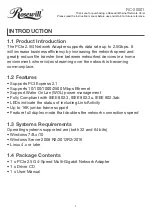
MDE-LEDI-NETWORK-TDS-4099V3.0
21
E
NG
LI
S
H
Here are the meanings of the different states:
►
Initial: The time server has just started up.
►
Synchronising: The time input is valid. The time server has selected it. It is waiting until
the time information is sufficiently accurate and propagated on the server before
activating its time output.
►
Synchronised: The synchronisation of the time server is complete. The synchronisation
outputs are operational It will continue to reduce the phase difference if possible.
►
Autonomous: The time server can enter this state if a user activates the autonomous
mode or if its time output is unavailable and a duration of autonomy configured.
►
Failing: The time server can enter this state if its time input is unavailable and no
autonomy time has been configured or the autonomy has been exhausted.
3.6. SNMP (SIMPLE NETWORK MANAGEMENT PROTOCOL) AND MIB
(MANAGEMENT INFORMATION BASE)
Please see RFC 1157 for mor information on the SNMP protocol. It enables you to read and
modify data from an agent (produced on the IP network) through requests sent to transfer
traps (alerts) sent automatically by an agent to a trap server. The default UPD ports are 161
for requests and 162 for traps.
In versions 1 and 2c, an SNMP server only responds to requests containing the specified
community name configured on the server. It is therefore necessary to configure the same
name on the client. By default, the community usually used by different softwar
e is ‘public’
for reading and ‘private’ for writing. There is no authentication mechanism, and the data
circulates in clear text on the network. Version 3 offers the USM (User-based Security
Model). This makes it possible to authenticate the client and the server to protect against
identity theft and even to encrypt the data to hide it. Authentication and encryption each
require a password of at least 8 characters known in advance to the client and server.










































